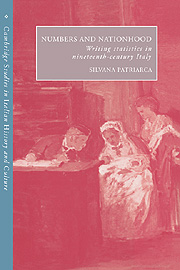Book contents
- Frontmatter
- Contents
- List of illustrations
- Acknowledgments
- Map 1 Italy during the process of unification
- 1 Introduction
- 2 A science for the “civilizing” of nations
- 3 The logics of statistical description
- 4 Official numbers
- 5 “Patriotic” statistics
- 6 The identity of the Italians
- 7 A map of the new nation
- 8 Center and periphery
- 9 Epilogue
- Appendix: Numbers of statistical publications
- Select bibliography
- Index
9 - Epilogue
Published online by Cambridge University Press: 14 October 2009
- Frontmatter
- Contents
- List of illustrations
- Acknowledgments
- Map 1 Italy during the process of unification
- 1 Introduction
- 2 A science for the “civilizing” of nations
- 3 The logics of statistical description
- 4 Official numbers
- 5 “Patriotic” statistics
- 6 The identity of the Italians
- 7 A map of the new nation
- 8 Center and periphery
- 9 Epilogue
- Appendix: Numbers of statistical publications
- Select bibliography
- Index
Summary
Rapid change took place in Italian politics and in official Italian statistics in the 1870s. After Pietro Maestri, one of the main promoters of patriotic statistics and the principal architect of official statistics in the 1860s, died in 1871, he was replaced in 1872 by Luigi Bodio (Milan 1840–1910). Bodio was a protégé of the then general secretary of the Ministry of Agriculture, Industry, and Commerce, Luigi Luzzatti, himself a student of Messedaglia and representative of the so-called “Lombard–Venetian school” of political economy which traced its roots back to the teaching of Romagnosi. Bodio was also strongly convinced of the high political and scientific mission of statistics, but clearly faced new tasks and a different intellectual climate. He introduced new methodological concerns and a more technical language into the official statistics of Italy, and gained a solid international reputation as head of the International Statistical Institute. Necessarily statistics in the new Italy could no longer be the charged symbol of liberalism, of representative institutions, and of rational government that it had been in the previous period in the midst of “autocratic” regimes. It had become an established institution in the state apparatus, a discipline taught in most universities and high schools.
With the annexation of Rome in 1870, the “dispersed limbs” of the national “body” had all (or almost all) been assembled together; the body was finally a whole, although its surface was still marked by wounds.
- Type
- Chapter
- Information
- Numbers and NationhoodWriting Statistics in Nineteenth-Century Italy, pp. 233 - 240Publisher: Cambridge University PressPrint publication year: 1996

